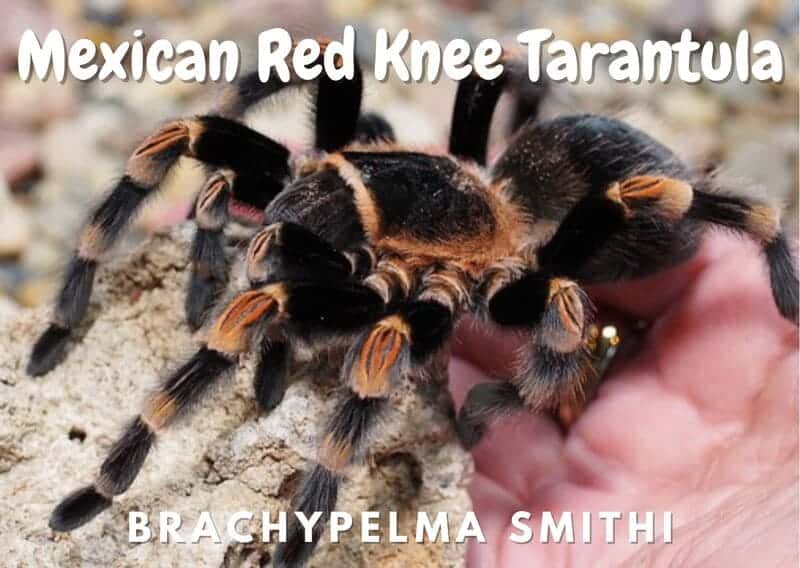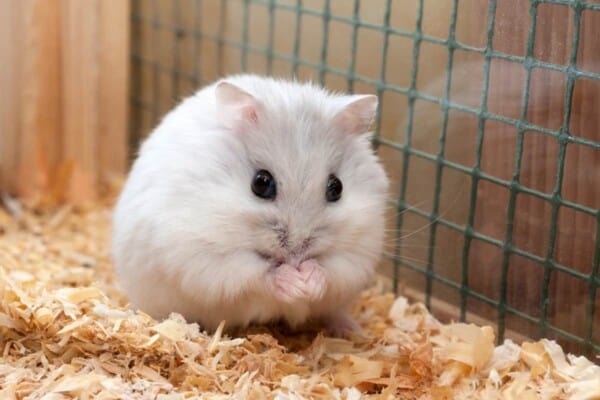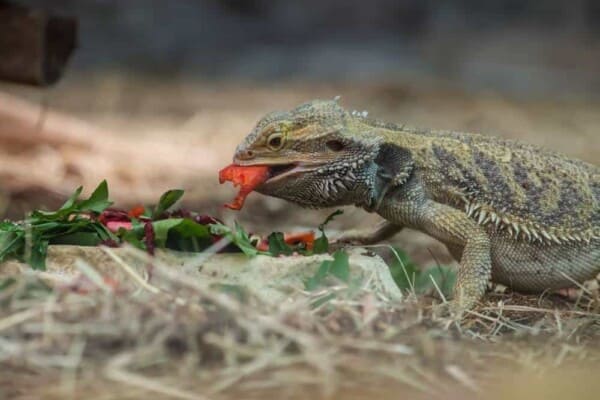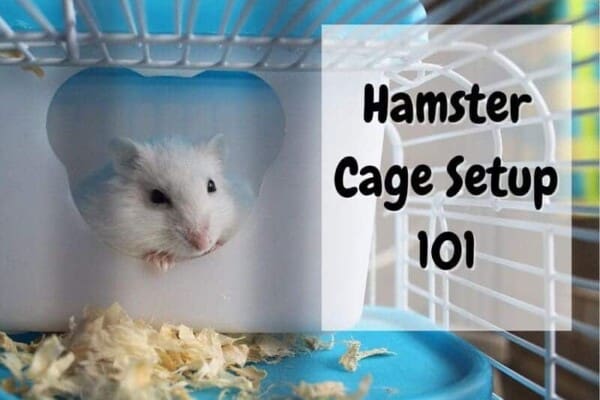The tarantula known as the Mexican red knee tarantula is a great pet to start with if you like spiders. They are the kind that many people like because they are cute and colorful. These tarantulas originated along the Mexican coast and are collected for their docile nature.
If you’re interested in owning a Mexican Red Knee for yourself, you need to learn about their needs. How to care for them and what they need to eat. We’ve collected all the best info you’ll need to start your own Red Knee habitat. And hopefully, even raise some of your own.
Mexican Red Knee Tarantula Overview
| Scientific Name | Brachypelma Smithi |
| Dwelling | Terrestrial |
| Size | 5 – 5.5 inches |
| Lifespan | 10 years (male) / 25-30 years (female) |
| Food | crickets, mealworms, cockroaches, and locusts, small pinky mice, lizards, small birds |
| Difficulty | Beginner |
Brachypelma Smithi -however, they previously shared the names Eurypelma Smithi FOP-Cambridge (1897) and Euthlus Smithi Baxter (1993)
Characteristics of the Mexican Red Knee
These terrestrial tarantulas originate from the Sierra Madre Occidental and the Sierra Madre Big Sur in Mexico. This tarantula is often confused with the Brachypelma Hamori, which looks similar but there are differences.
The Brachypelma Smithi is considered a New World tarantula and is identified by the urticating setae found on their knees and abdomen. They often have vibrant orange to red-orange colors on their patella and some smaller patches of red color below their patella.
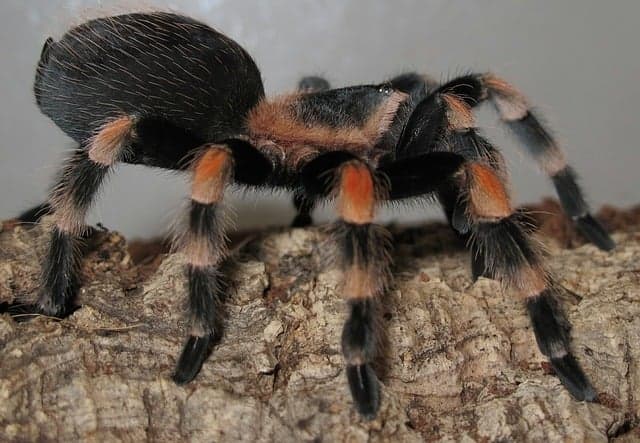
This red knee also has a carapace colored with a creamy warm beige enclosing a black rectangular square in the middle. Other identifiable attributes include a cephalothorax that’s colored black and has a khaki-colored ring.
Size
Between the male and female red knees, there is very little to tell them apart until they become adults. Adult females tend to be more bulky or chunky than males. An adult can have a body length between 7-8 cm, which spans 15-18 cm overall.
Females will go through a teenage growth period that appears to have lanky legs that some owners mistake to be male tarantulas. However adult males also have boxing-like tibial hooks (palps) that are cream-colored. Males will also have longer legs and more narrow fangs.
Lifespan
It’s the same story you hear all the time when it comes to living fast and dying hard. Adult male red knees will only live a maximum of 10 years. Females, on the other hand, will live up to 20-30 years.
Difficulty of care
This species is perfect for any beginner because of its docile nature. They are very mild-tempered and seldom become stressed if you want to pick them up or hold them in your hand. Besides that, they are very slow-moving and make these tarantulas easier to catch and put away.
Housing the Mexican Red Knee Tarantula
There is no special enclosure that is required for the red knee, so any 5-10 gallon reptile tank is perfect. These tanks can be glass or plastic, but for long-term use, glass is recommended. As a rule of thumb, the tank width should be 2-3x wider than your tarantula’s leg span. The height can be ideal as long as their leg span would be if they stretch out all their legs.
The tank should have a tight-fitting lid since the tarantula is a capable escape artist. If your reptile tank has a built-in door to it, make sure there is a secure latch that keeps it closed.
Accessories
Once again it comes down to choice but considering that your tarantula is coming from a sub-tropical place. It will feel at home in an environment that best suits their needs. You do need to give your Red Knee tarantula some housing options such as a water dish and hiding place. Try a jungle theme with some plastic plants and coconut shells or a half-shelled ceramic pot.
Humidity
These tarantulas once lived in a subtropical area where the temperature and humidity were continual. You should have a humidity level between 60-70% though in average cases you can get away with 50-60% in your home. The container should be able to hold that humidity enough that it doesn’t escape so easily. This is achieved by misting the enclosure every so often with a spray bottle. Most owners will find that their water bowl is the main source of water evaporation too.
Some owners will opt to have a heating pad on one side of the tank to keep the temperature constant. The other half of the tank should be cooler, so your red leg can have a place to chill out. It all depends on how much you want to replicate their native environment. Happier spiders will be healthier if they have all the comforts of their native home.
Temperature and Lighting
Lighting not only gives you and your spider the illusion of daytime, but it also provides a constant temperature. Except for nighttime simulation, you should keep a daytime temperature of 75-80F. The light cycle should be 12 hours of light and 12 hours of the night. The night temperature can drop to at least 20-22F, though your red knee will be in its burrow anyway.
The light itself should be an incandescent lamp which should be outside the tank and above the lid cover. The lid cover should be clear enough so that light can get inside. If you want to be fancy, you can use a dimmable light to adjust the light to your liking. Be sure to have a thermometer strip that measures temperature and humidity.
Substrate
Most Red Knee owners will choose a mixture of peat moss, soil, and some vermiculite that is 4 inches thick. The reason for the thickness is so they can burrow into the substrate to make a den. Vermiculite is used to keep moisture within the soil. Peat moss is a buffer that keeps your spider dry enough when they walk over the mixture. The recipe should be 50% peat moss, 30 % topsoil, and 20% vermiculite.
As an alternative, you can also use coconut fiber instead of peat moss. The coco fiber also helps mold growth from forming. It’s a natural fiber that prohibits bacteria from growing. This recipe starts with 50% coco fiber, 25% topsoil, and 25% vermiculite. You may also use fine to coarse sand within the mixture as you like.
Your red knee likes a soil substrate that can be burrowed into. Much like the forest floor, they live on, the closer it matches a native environment the better. After mixing the soil mixture you need to add a bit of water. It should be a bit like clay. If it’s dripping water, it’s too wet. If it crumbles it will be too dry. Find the medium point where your tarantula can burrow a hole and it won’t collapse.
A new technique that is gaining traction in the tarantula hobby world is pre-fitting a drainage layer at the very bottom of the tank. This can be gravel or Hydroton clay balls that form a layer 2 inches thick at the bottom of the tank. This should have a semi-flexible mesh cover placed on top and then your substrate covering that. It will allow excess water to safely drain away to maintain consistency.
Cleaning
How often you clean will depend on the type of substrate that you lay down on the tank floor. It should not be too wet or too dry. Certain substrate content that has living soil can promote mold and fungus growth. This is bad for the Red Knee since it needs to burrow a nest. It’s an issue that you’ll need to determine if it’s time to clean the tank and start with a new substrate.
Feeding your Mexican Red Knee Tarantula
In their native environment, the Mexican red knee will eat whatever crosses its path. When they are on the hunt they will be outside their lair just waiting for dinner to stroll by. This includes crickets, mealworms, cockroaches, and locusts.
They have been known to eat small pinky mice and lizards and even little birds if they can be caught. Smaller spiderlings will eat wingless fruit flies and mealworms.
How often do Mexican Red Knees need feeding?
For adults, you can offer at least 5 different variations once a week for them to consume. If they eat all of the food that is offered, you should remove any left-over insects that have been drained.
Anything that is still living should be removed. Spiders can become stressed after they’ve fed so wandering bugs and little animals are considered a threat.
Spiderlings are different and should eat twice a week. They need smaller food sources so choose the appropriately sized insect that they can handle.
Some red knees will stop eating for a month right before a molt, so keep track of their eating habits. These notes will allow you to track their eating and figure out their molting habits.
Drink
A water dish for your tarantula is a highly debated issue. Some believe still that a shallow dish with cotton at the bottom is best. Breeders will tell a different story.
A simple shallow dish with fine polished gravel is enough to use for your red knee. The gravel is so they don’t step in the water and when filled with water, it helps to keep humidity. Cotton can promote bacterial growth, which is bad for your spider.
Handling the Mexican Red Knee Tarantula
This species of tarantula is the most relaxed of the bunch. They can be skittish at times but careful handling will allow them to learn they are not being threatened. Most of the time if they feel threatened they will flick their urticating hairs onto your hand. All that this does is result in a short-term light rash. You should wash your hands immediately if they do this.
They seldom bite since they are not temperamental as other tarantulas can be. If they feel too threatened, they will resort to biting. But thankfully their venom is not lethal. It is equal to a bee sting. There is a possible chance you could be allergic to their venom too. If you suffer from bee stings in any way, the red knee venom may cause similar allergic reactions.
Health problems encountered by the Mexican Red Knee
There are only a couple of things that you should do to prevent health problems in your Mexican red knee. The first has to do with hydration, which is why you should always make sure they have enough humidity. The second is too much humidity, as this will stress them further. They will often move to the corner of the tank to find a cooler area.
Always monitor the heat and humidity levels to ensure their well-being. When it comes to their annual molting they will show signs that look like bad health. They will not eat for a month (this is to be thin enough to get out of their old exoskeleton). Some owners are shocked to see them laid on their backs and even try to flip them. Don’t, this is normal and they do this to exit their old shell easier.
They are also very fragile and even falling from small heights can hurt or kill them. Their exoskeleton is thin like an eggshell so handling your spider should be on a carpeted floor. You should be sitting when handling them in case they get spooked and fall on the carpet.
Breeding the Mexican Red Knee Tarantula
If you have two mature tarantulas that are both male and female, you will have a chance to see their mating ritual. Males will be ready to mate when they are 3-5 years old. After his maturing molt, he will ready his sperm silk. This is a special web that contains the sperm he will use for the female. If your female is two to three years older than the male, she is ready for reproducing.
After the male spider has molted you need to allow 4-6 weeks for your red knee male to get ready for his sperm collection. You’ll also notice that he has woven a special web at the ends of his palps that contain the sperm he will use to impregnate the female. These often look like boxing gloves.
The female will produce between 200-500 eggs at one time. In some rare cases she can lay up to 1000, but conditions would need to be just right. She keeps these eggs protected in her burrow until they hatch. It will take 8-10 weeks for the eggs to hatch.
What to do with the spiderlings
After the female has guarded the nest for 8-10 weeks the babies will hatch. You will not see them come out for an additional 2 weeks. Keep an eye on the time when your female is impregnated and goes to retreat to her lair. Little spiderlings will start to come out after 12 weeks. At that point expect a hungry stampede!
The little tarantula spiders will molt every two weeks for the first four months. It’s important to put them into their terrariums so they have time to grow. Breeders will often sell off most of them to avoid too much space taken up by hundreds of red-leg babies to feed.
Availability of the Mexican Red Knee Tarantula
The best way to purchase your Mexican Red Leg tarantula is through an authorized dealer or breeder who has creditability. Many breeders are selling another species called Brachypelma Hamori, which is also called a red knee. It is smaller and not as colorful so be forewarned about determining the species.
Many corner pet stores are often fooled into buying a red knee tarantula not knowing which species they bought. Always be sure to ask about the actual species’ name. You might even risk being overcharged for a species that is more common than you think.
Resources and further reading:
- Brachypelma of Mexico, Rick C. West
Contents
- Mexican Red Knee Tarantula Overview
- Characteristics of the Mexican Red Knee
- Housing the Mexican Red Knee Tarantula
- Feeding your Mexican Red Knee Tarantula
- Handling the Mexican Red Knee Tarantula
- Health problems encountered by the Mexican Red Knee
- Breeding the Mexican Red Knee Tarantula
- Availability of the Mexican Red Knee Tarantula

